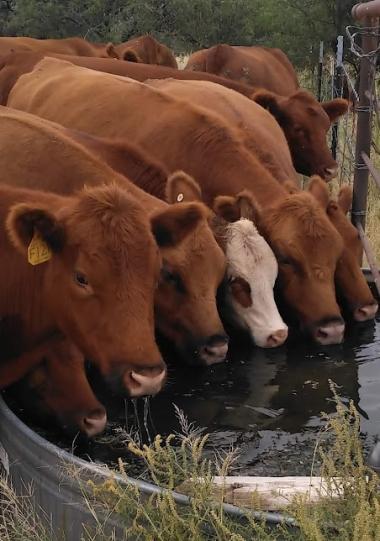Current Grazing Schedule
Beginning in November 2006, a new livestock grazing management scheme was implemented on the SRER under the supervision of Dr. George Ruyle (University of Arizona), in cooperation with Andrew McGibbon who owns the livestock. This new management replaced the “Santa Rita Grazing System” experiment that was in place since 1972 (Martin and Severson 1988; Mashiri et al. 2008). The new scheme applied adaptive grazing management principles to establish expected dormant season grazing capacity based on summer forage production, and summer grazing periods based on avoiding the re-grazing of plants in the summer growing season. Forage production and utilization and livestock movement patterns are periodically monitored to forecast forage availability and the likelihood of re-grazing plants in the summer growing season.
The new scheme applies adaptive grazing management principles to establish expected dormant season grazing capacity based on summer forage production, and summer grazing periods of only 10 days to avoid the re-grazing of plants in the summer growing season (Noelle et al. 2021). The adaptive management elements include 1) use of summer production values to re-adjust stocking rates each fall, 2) start and duration of the summer growing season to determine when livestock should be moved between pastures, and 3) flexible pasture use to support the variety of research projects being performed on the Santa Rita.
Currently, there are two herds moving through the SRER pastures. The large herd of ~350-500 animals, moves through a combination of 21 pastures, 15 located on the Santa Rita, 3 on the Coronado National Forest, and 3 on Arizona State Lands. The small herd, ~70 animals, moves through 11 pastures all but two on the Santa Rita. Herd size was reduced in 2020-2021 because the summer growing season in 2020 was extremely dry and hot, and resulted in very little grass production.
Dr. Ruyle and associates measure forage production and forage utilization, livestock movement patterns, and developing methods to forecast forage availability and the likelihood of re-grazing plants in the summer growing season. In addition, virtual fencing monitoring and management are now implemented in the framework of the VENCE research project.
Researchers, instructors, and other interested parties are advised to consult the livestock plan tables and maps (see below) to learn the specific location, timing, and the number of livestock expected in each pasture; as well as the actual use in those areas. Be aware that 1) some animals may appear in pastures outside these expected periods because of handling problems, 2) livestock use of unintended pastures is not shown in the report below, and 3) adjustments to timing and numbers can be made to accommodate research and instruction needs. Since November 2008, a new practice has been implemented by opening pasture gates 1-2 days before the official start date for grazing in the new pasture. Typically, the gates will open 1 day earlier, but the 2-day window will be common when there are frequent moves (every 10 days) during the summer growing season. This practice is being adopted to reduce the separation of calves from cows during the move between pastures.
The current grazing plan on the Santa Rita Experimental Range (SRER) is available above for download.
References
Martin, S.C. and Severson, K.E. 1988. Vegetation response to the Santa Rita grazing system. Journal of Range Management 41, 291-295.
Mashiri, F.E.; McClaran, M.P.; Fehmi, J.S. 2008. Short- and Long-Term Vegetation Change Related to Grazing Systems, Precipitation, and Mesquite Cover. Rangeland Ecology and Management 61, 4, 368-379.
Noelle S., Lyons T., Gorlier A., McClaran M.P., Nichols M., Ruyle G. 2020. How Long Before a Second Defoliation of Actively Growing Grass Plants in the Desert Grassland? Frontiers in Veterinary Science 7, 1023, 1-7.



